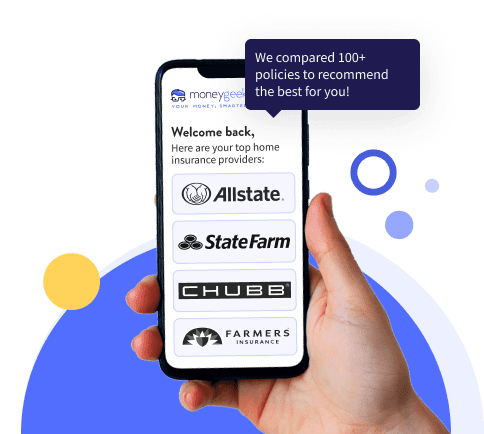Home insurance inspectors look for potential risks or hazards, including the condition of the roof, plumbing, electrical and HVAC systems, plus overall maintenance and safety. They verify your application information's accuracy and determine the property's insurability. Inspectors examine your home's interior and exterior.
Homeowners Insurance Inspection: What to Expect and How to Prepare
A home insurance inspection involves an inspector evaluating your home's interior and exterior for potential risks that may affect coverage and premiums.
Find out if you're overpaying for home insurance below.

Updated: June 27, 2025
Advertising & Editorial Disclosure
Key Takeaways
Insurance providers use information from a homeowners insurance inspection to determine coverage adjustments and premiums.
Insurance inspectors examine the roof, plumbing, electrical and HVAC systems of your home to assess the property's overall safety.
Prepare for a homeowners insurance inspection by inspecting exterior and interior systems yourself and ensuring safety measures are in place.
Compare Home Insurance Rates
Ensure you're getting the best rate for your home insurance. Compare quotes from the top insurance companies.
What to Expect During a Homeowners Insurance Inspection
Homeowners Insurance Interior Inspections
Interior inspections check inside your home to ensure everything meets current building codes. Inspectors examine various elements that might affect your insurance cost and coverage, including the house's overall condition, structure, wiring and plumbing.
Structural and General Maintenance
Checking for structural integrity, including foundation, walls and roof condition, plus overall maintenance and signs of neglect or disrepair.
Electrical and Plumbing Systems
Assessing the condition of electrical wiring, circuit breakers, plumbing systems and potential water damage risks.
Heating, Cooling and Fire Safety
Evaluating the HVAC system's functionality and age, plus fire safety measures like smoke detectors and fire extinguishers.
Potential Hazards and Security:
Identifying potential hazards that could cause injury or damage, and reviewing home security features like alarms and secure locks.
Recent Updates and Renovations
Noting recent home improvements or renovations that might affect the home's value and safety.
Homeowners Insurance Exterior Inspections
Exterior inspections check the outside of your home for safety and maintenance issues. Inspectors identify problems or hazards, like a worn-out roof or wall cracks, that could lead to bigger issues. They examine your yard and nearby elements, such as large tree branches, that could pose risks.
Roof Condition
Assessing the age, condition and type of roofing materials, plus signs of damage, wear or repair needs.
Exterior Walls and Foundation
Checking for cracks, damage or deterioration in exterior walls and foundation that could indicate structural issues.
Landscaping and Grounds
Evaluating landscaping condition, including trees and their proximity to the house, to identify risks like falling limbs or root damage.
Additional Structures and Features
Inspecting other property structures, such as garages, sheds, decks, pools and fences, for condition and safety.
What Is a 4-Point Inspection for Homeowners Insurance?
A 4-point inspection for homeowners insurance is a focused evaluation often required by providers, especially for older homes, that assesses four critical areas: HVAC systems, electrical wiring and panels, plumbing and the roof. It identifies major issues or potential risks that could affect the home's insurability and the insurance provider's risk.
Required for homes over a certain age, the 4-point inspection provides insurers with a concise overview of the home's current state, helping them make informed decisions about policy issuance and pricing:
HVAC (Heating, Ventilation and Air Conditioning)
Assessing the state and functionality of the home's heating and cooling systems, including age, maintenance history and overall condition.
Electrical Wiring and Panels
Evaluating the electrical system, including wiring, circuit breakers and electrical panels, checking for outdated wiring, safety issues or signs of potential electrical hazards.
Plumbing
Examining pipes, faucets, water heaters and other plumbing system parts, looking for leaks, outdated piping materials (like polybutylene or galvanized steel) and overall condition.
Roof
Assessing age, condition and signs of leaks or damage, plus evaluating life expectancy and immediate repair needs.
Do You Need an Inspection for Homeowners Insurance?
A home insurance inspection isn't always required when purchasing homeowners insurance. However, your insurance company may require an inspection within the first 30 to 60 days to ensure your application accurately reflects the home's value and risk. Inspection results could change your coverage amount and may require you to address issues before the policy takes effect.
Situations where a home insurance inspection may be required:
- If you are a first-time buyer/customer
- If you own an older/outdated home
- If you have a high-value home
- If you live in a disaster-prone area
- If you had structural changes or major home renovations
- If you are renewing your policy
- If you are switching to a new insurance company
- If your home’s replacement cost is difficult to determine
How to Prepare for a Home Insurance Inspection
Your insurance company might send an inspector to check your home before finalizing your policy. The inspector looks for damage, safety issues and maintenance problems that affect your rates.
- 1
Clean and Declutter
Keep your home clean and clutter-free. This makes a good impression and allows the inspector to access all areas easily.
- 2
Check Your Home's Exterior
Inspect the exterior for damage, such as loose roof shingles or siding. Make sure gutters and downspouts are securely attached and free of debris.
- 3
Inspect Interior Systems
Verify that electrical, plumbing and heating/cooling systems work properly. Replace outdated or malfunctioning elements.
- 4
Ensure Safety Measures Are in Place
Check that smoke detectors and carbon monoxide detectors function properly. If you have a security system, ensure it's operational.
- 5
Document Updates and Repairs
Have documentation ready for recent updates or repairs, including receipts, contracts and before-and-after photos.
- 6
Review Your Personal Property
Create an updated inventory of personal property, especially high-value items. This helps if you need to update coverage limits.
- 7
Prepare Your Questions
Be ready to ask questions about your coverage or the inspection process. This is an opportunity to understand your policy and potential changes.
What if You Failed Homeowners Insurance Inspection
If you failed a homeowners insurance inspection, your insurance provider may refuse to renew your policy or may increase your premiums or deductibles. This happens when an inspector identifies significant risks or hazards that make your home high-risk for coverage. Scenarios that could cause you to fail include:
- Outdated electrical system that poses a fire hazard
- Lacking basic safety measures like smoke detectors and fire exits
- Neglected plumbing system that could lead to burst pipes
- Poorly maintained roof that is susceptible to water damage
The insurance company might offer conditional renewal, requiring specific repairs or improvements within a set timeframe. If you don't meet these conditions by the deadline, the company can cancel your policy. The company could also void your policy from its start date if the inspection uncovers previously undisclosed risks. This leaves you without coverage and facing back charges for the period you were insured.
Address any known issues before the inspection and be transparent about your property's condition.
Can You Get Homeowners Insurance Without an Inspection?
You can get home insurance without a home inspection, though this depends on the insurance company's policies and your home's circumstances. If your house was recently purchased and inspected during closing, or if the previous owner had it inspected within the last year, a new inspection might not be necessary.
New customers, those with older homes or homes needing repairs that are difficult to assess remotely may still require an inspection. Consult with your insurance broker or agent to determine if an inspection is necessary for your situation.
Home Insurance Inspection: Bottom Line
While homeowners insurance inspections aren't always required, insurance providers may ask you to undergo one to evaluate your home's insurability and risks. Preparing for inspections helps reduce risks and fix minor problems in advance, preventing premium increases or inspection failures that could lead to policy cancellations.
The inspector walks through your house, checking inside and out for problems that could lead to claims. What they find affects whether your insurer keeps your policy and how much you pay. Fix obvious issues beforehand so you don't get stuck with higher rates or cancelled coverage.
Compare Home Insurance Rates
Ensure you're getting the best rate for your home insurance. Compare quotes from the top insurance companies.
Home Inspection for Insurance: FAQ
We answer frequently asked questions about home insurance inspections, clarifying their purpose.
Is a home inspection required for homeowners insurance?
You might be able to get homeowners insurance without an inspection, depending on the insurer's policies and your home's condition. Requirements vary by insurance provider and situation. Inspections help the insurer assess the property's risk and determine appropriate coverage.
What do insurance inspectors look for?
Insurance inspectors look for potential hazards around your property, checking the condition of the roof, electrical and plumbing systems, HVAC systems and general maintenance of interior and exterior areas. They also check for safety features like smoke detectors and the home's overall structural integrity.
Home Inspection for Homeowners Insurance: Our Review Methodology
Why Trust MoneyGeek?
MoneyGeek analyzed quotes from multiple insurance providers across the U.S. using a profile that reflects the average homeowner. By considering different locations and companies, we aim to give a reliable estimate of what homeowners can expect to pay — showing why it’s important to compare rates.
Methodology
MoneyGeek evaluated homeowners insurance carriers incorporating insights and premiums from the official databases of Quadrant Information Services.
Homeowner Profile
For our analysis, we created a sample homeowner profile with the following characteristics:
- Good credit score (769–792)
- Home constructed in 2000
- Wood-frame construction
- Composite shingle roof
Homeowners Insurance Coverage Details
Unless otherwise specified, we used the following coverage limits to collect quotes for our comparison:
- $250,000 in dwelling coverage
- $125,000 in personal property coverage
- $200,000 in personal liability coverage
- $1,000 deductible
We also compiled data for policies with broader coverage to determine the best companies for insuring expensive homes, upping limits to $1 million in dwelling coverage, $500,000 in personal property coverage and $1 million in liability coverage.
Inspection for Homeowners Insurance: Related Pages
About Mark Fitzpatrick

Mark Fitzpatrick, a Licensed Property and Casualty Insurance Producer, is MoneyGeek's resident Personal Finance Expert. With over five years of experience analyzing the insurance market, he conducts original research and creates tailored content for all types of buyers. His insights have been featured in publications like CNBC, NBC News and Mashable.
Fitzpatrick holds a master’s degree in economics and international relations from Johns Hopkins University and a bachelor’s degree from Boston College. He's also a five-time Jeopardy champion!
Passionate about economics and insurance, he aims to promote transparency in financial topics and empower others to make confident money decisions.

